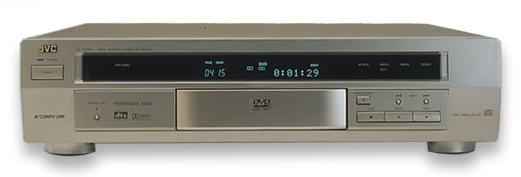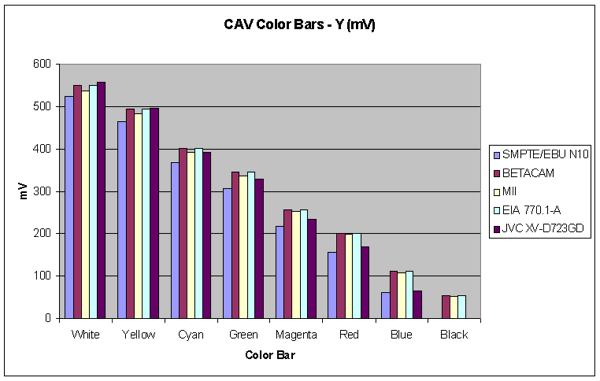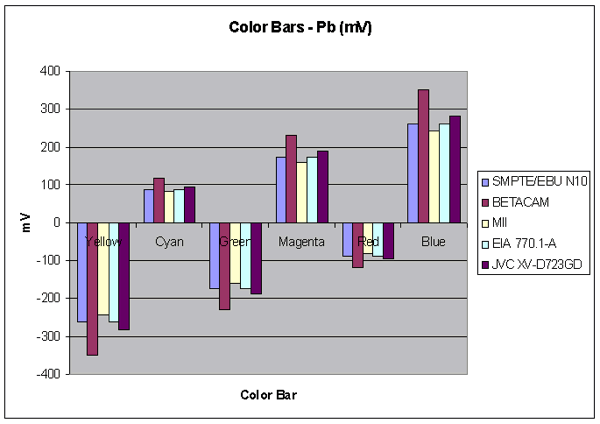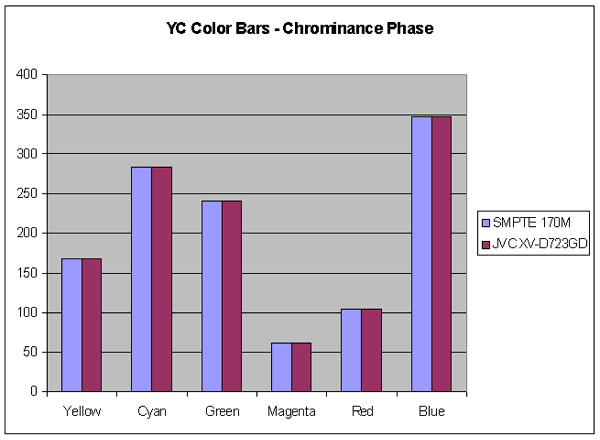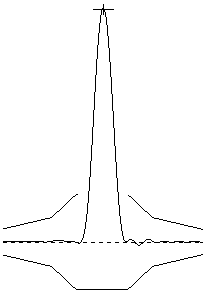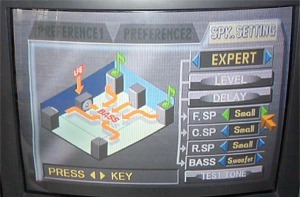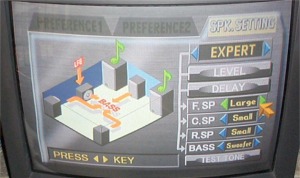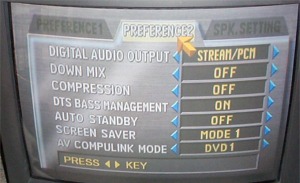DVD Benchmark - Product Review - JVC XV-D723GD Progressive Scan DVD-V/DVD-A Player - February, 2001 Staff
Introduction
The JVC XV-D723GD, at $899 MSRP, is one of the lowest price Progressive Scan DVD-A players on the market today.
Anyway, here are our test results:
Video
The overall video quality of the 723 is good. The de-interlacing on the progressive output is done by reading the flags on the DVD. The quality of film-based material will be determined by the accuracy of the encoding.
The strange anomaly of this DVD player is that its interlaced output is based on the progressive settings. That means if you change the progressive mode on the player, it does affect the interlaced output. The MPEG decoder they are using has the ability to output an interlaced picture, but JVC does not appear to have implemented that correctly. Also, to change between interlaced and progressive you must use a switch located on the back of the player. They have labeled the switch 525 instead of 480. This has confused more than one person, but rest assured, they represent the same thing. The NTSC TV system does contain 525 lines but only 480 are actually usable, hence the confusion between 525 and 480.
This DVD player has wonderful scaling. You can zoom into an image many times over, and the quality is excellent. They are using an 8-tap filter to perform the scaling, and it shows.
The component outputs are correctly labeled, and they use the inferior RCA connectors.
Black and White Levels
Format Black White Comments CAV 0.0 104.3 There is no setup on black, and we could not find an option to turn it on. White is hotter than it should be. YC 0.0 99.8 The YC Black is the same as the CAV Black, but white is where it belongs unlike the component output. Color Bars
CAV
The Y out of the CAV channel starts out hot and then drops down with each color. It never really follows any standard.
The Pb portion of the CAV output is above everything but Betacam. The Pr portion of the CAV output is above everything but Betacam.
Component Analog Video Data
YC
The Y level of the YC output is slightly lower than SMPTE 170M at white and drops even lower with each color.
The chroma level is higher than SMPTE 170M. The Chroma phase of the YC output is virtually perfect.
Composite/YC Data
Video Frequency Response
We are including both a video frequency response and a 2T pulse for the JVC DVD player.
As you can see (figure shown below), the video frequency response begins to roll-off just after 1 MHz. The YC output is below the CAV output the entire time. Here is a good case where the CAV output should be a hair sharper than the YC when the sharpness control is properly set. The player is down 1.38 dB at 5 MHz. In reality, this is pretty good. The 723 does not have the image crispness that the Toshiba's, Pioneer's, or new Sony have.
The CAV 2T pulse is shown below. You can see that, overall, the 2T looks very good with barely any overshoot.
The Avia sharpness pattern has virtually no ringing on it.
We have also included a digital photo of the progressive output frequency response. The progressive output seems to match the interlaced output in terms of frequency response.
Video Frequency Response
Interlaced
2T
Progressive
Pixel Cropping
We did not get a chance to measure the pixel cropping of this DVD player.
Signal-To-Noise Ratio
Format Output SNR (dB) Comments CAV Y -60.0 OK - Overall, the noise in the Y channel is a little high. There is a small peak just after 1 MHz and the normal spike at 3.58 MHz. CAV Pb -65.7 Good - This is the minimum performance expected from a DVD player. CAV Pr -66.3 Good - This is the minimum performance expected from a DVD player. YC C-AM -66.0 Very Good YC C-PM -68.5 Very Good Component Channel Timing
We used the Tektronix 1735HD to get a look at the progressive output timing. We have included a digital photo of the progressive outputs. The interlaced values are in the table below.
The JVC test result is a textbook example of what component timing should look like.
Component Channel Timing
Progressive
Channel Timing (ns) Comments 'Pb' to Y 0.2 Stellar 'Pr' to Y -0.4 Stellar 'Pb' to 'Pr' 0.6 Stellar - Stacey Spears -
Audio
Configuring Bass management
Kudos to JVC for getting this right! For Dolby Digital and DTS decoding, the JVC bass management has nice flexibility for your system. Crossover for Dolby Digital (and presumably DTS) is fixed at 80 Hz for all speakers defined as "Small.There are several configuration possibilities out of the box. "2 Channel" (a misnomer) is really a 2.1 channel configuration, with no test tones available for calibration. "5.1 Channel" is a fixed configuration, with mains set to "Large", center and surrounds to "Small", with subwoofer test tones not available.
Finally, we get to "Expert" mode, which offers complete flexibility for you to configure the system. Below is a table to show the available options for speakers in Expert mode.
Menu Item
Setting
Function
Fronts
Large
Selectable, large or small.
Center Channel
Small
Selectable, large or small.
Surrounds
Small
Selectable, large or small.
Surrounds
On
Sets surrounds on or off.
Subwoofer
On
Sets Subwoofer on or off.
Center Delay
0ms
Delay time from 0ms to 15ms (5ms increments)
Surround Delay 5ms Delay time from 0ms to 15ms (5ms increments) The Expert mode is so flexible that I took a couple of pictures of the screen to show the configuration flexibility. No laughter about the TV screen shots please, I'm still in the learning phase with my new digital camera!
Here, we have all speakers configured as Small, showing bass being redirected to the subwoofer for all speakers.
This is the appearance of speaker settings with the front speakers set to Large. Notice that the fronts show no redirection of bass to the subwoofer.
The Preference 2 screen is used to configure the audio portion of the player (and some other features). Digital Audio Output has three choices: PCM Only used to output only CD audio as a digital signal, Dolby Digital/PCM used to output DD encoded discs and CDs as a digital signal, and Stream/PCM which outputs DTS and DD encoded discs and CDs as a digital signal. The digital audio outputs are active when all disc types except DVD-Audio are in the player. When DVD-Audio discs are playing, no digital output is available. Dynamic Compression is used for late-night viewing, and/or in conjunction with Down Mix. DTS Bass management allows the system to do full bass management on DTS discs, as opposed to treating all speakers as large.
When playing back a disc (of any type) a channel legend appears in the display showing the number of channels present. Anywhere from 1.0 all the way to 5.1. In an attempt to deceive the player, I stuck in a DTS encoded CD. It started off showing 2 channels (for stereo) and after about 1 second switched over to show 5.1 channels. When playing back DVD-Audio discs, an indicator light on the left hand side of the display (blue) comes on. Sampling rate is indicated by 3 different lights: one for 44.1/48KHz sampling rate, one for 88.1/96KHz, and one for 176.4/192KHz.
The display can be shut off, but you have to do this from the front panel, because no button is included on the remote to turn the display off. Even when the display is off, it only kills the busy center portion of the display - the Display Off indicator light is on (red), DVD-Audio lights up for DVD-A discs, and sampling rate is always displayed. Much less than "standard", but still not really "Off" to me.
How does it Sound????
I had this player in my system first and last (before the Sony and Onkyo players were here), and after the Sony had departed. If it were 1996 or 1997, I probably would have rated this players performance as "good", but unfortunately the XV-723GD didn't live up to the competition of the Onkyo DV-S939. Yes, I'm aware of the price disparity, but I'm talking in absolute terms.
I have a few DTS encoded music CDs, and for variety's sake, I threw one into the mix this time around to test out the DTS decoder in the XV-723GD.
Lyle Lovett, Joshua Judges Ruth, Curb/MCA 71021-54430-2-7 (DTS encoded Compact Disc)
For those of you who enjoy multi-channel music, I heartily recommend this title to you. It is a great example of a DTS encoded surround disc with a variety of mixing techniques, from musicians all around you, to subtle effects, with the front soundstage heavily favored. It's only weakness is some sibilance on the lead vocals, which can be exaggerated on lesser components. But, remember, DTS CDs are compressed, and are represented by only a small fraction of the bits that are contained on a DVD-A.
"She's Already Made Up Her Mind"
This track has some wonderful bass reproduction, and a nice collection of transients via bass drum kicks, and acoustic guitars strummed forcefully at times. Using the internal DTS decoder, I found the modest sibilance to be exaggerated. In addition, acoustic guitar missed some of the roundness it should have on longer held chords. The kick (bass drum) and electric bass didn't weigh in with their customary authority.
Transferring over to the digital output and using the B&K's DSP and DTS decoders made a substantial difference in performance, with all my critiques removed, save for a modest amount of sibilance which is in the recording.
"Baltimore"
A sparse arrangement is used, with voice, acoustic guitar, some electric guitar effects and a cello. It isn't an aggressive sound mix, and only the guitar effects wander out of the front of the soundstage, to punctuate certain lyrics.
Via the JVC's decoder, the sibilance was heightened, and the cello (at about 3:00) sounds like a toy - not the rich, warm tonality that belongs on this instrument. There are numerous subtle details on the vocals for this track, from breathing to lip smacking, and other assorted things which remind you a person is actually singing this song. Unfortunately, the JVC falls short on delivering the nuances that are there.
When using the B&Ks digital input, once again, a great improvement was garnered sonically over the internal DTS decoder of the JVC player. Sibilance was down to a more acceptable level, the cello's tonality was back where it belonged, and the nuances of Lyle Lovett's performance were restored.
Conclusion: Use the digital output for DTS (and also Dolby Digital material) if your system supports decoding of these formats via digital input.
DVD-Audio material
A new title appeared at my house after the Onkyo review was submitted, and I'm referencing other cuts from the samplers and DVD-A discs I received, so there won't be a tremendous overlap in materials.
kd lang, Invincible Summer, Warner Bros 9 47605-9
This is the new disc that arrived, a collection of 12 finely crafted pop songs, recorded well, and with a very engaging performance to boot. It'll end up in my collection of reference material for DVD-A. If you have a DVD-A player, and enjoy popular music, go to the trouble of getting this disc into your collection.
"It's Happening With You"
This is an interesting composition for the musician in me. The verse is a 12 bar blues variation, and the chorus is nine bars (unusual to have an odd number of bars) with a two-beat, dare I say "disco" feel? Once again, sibilance abounds from the JVC, which was notably absent on the Onkyo. Lang's lead vocals lose the crystalline quality that the Onkyo produces effortlessly. Electric Bass sounds "flabby" and unfocused, with pitch definition lacking. Real strings are used in this recording, and the JVC makes them sound like synthesized strings from the 70s during the chorus.... Yes it's a disco feel, but the Onkyo doesn't make them sound like badly synthesized strings of the era.
"Extraordinary Thing"
This is a catchy pop tune, and allows kd to dart all over the melody with some excellent results. Unfortunately, I find the XV-723GD to come across as uninvolving, with the lead vocals lacking that "you must listen to me" quality that was so appealing on the Onkyo player. Strings are still covered with an artificial sonic signature that leaves me feeling a little bit less than thrilled with the player.
Emerson, Lake and Palmer, Brain Salad Surgery, Rhino R9 75980
"Karn Evil, 1st Impression, Parts 1&2"
I'm trying to think of something catchy to describe this track. How about "A Progressive Rock Surround Sound Pyrotechnic Festival"? Aggressive use of sound, as the Moog Synthesizer bounces around merrily from channel to channel. So do the vocals from Greg Lake. On the JVC, Carl Palmer's percussion instruments (cymbals, cowbells, drum hits) all seem to be missing the high frequency sound that makes or breaks the reality of the instrument. At about 4:00 into this track, Emerson's Moog should cut through the thickness of the instrumentation more, and the notes should have more definition in his nimble fingered passages.
All sounds on this disc were produced by three humans, and an unknown number of tracks on the mixing console.
Aaron Neville, Devotion, Silverline Records 81028-9
"Bridge over Troubled Water"
After this started off, immediately I knew it wasn't quite right. The drummer's high hat didn't have correct timbral characteristics when open or closed - with no substance to the sound of the high hat when struck in opened position. Backing vocals aren't as fleshed out as they are on the Onkyo player, and possess a substantial sibilance (the "s" sound in human voices is over emphasized) that isn't pleasing. The center channel contains bass guitar, and doesn't deliver the weight it should be on this track. The vibrato utilized by Aaron Neville loses definition at times, and the illusion of his presence in the room is not portrayed as convincingly as with the Onkyo Player.
Joni Mitchell, Both Sides Now, Unknown Catalog Number:
"Both Sides Now"
My listening notes say, "The mechanism is really noisy". From my listening position about 14 feet from the player, as the laser advances from track to track, it's plainly heard. Joni's voice is lacking the characteristic huskiness that belongs on this recording. By taking this quality away, some of the impact is left behind - a shame, when properly reproduced, the melancholy tone of this song is delivered. If it's lacking, it's merely a decent song. Wayne Shorter makes a guest appearance on soprano saxophone for some solo fills, and the body that belongs to his soprano tone isn't clearly reproduced. It's reduced to a two-dimensional representation of his sound, kind of a "Wayne Shorter - Light".
There were other recordings I listened to and took notes on, but in the end the conclusion is the same for all media played back through the JVCs internal decoding.
Audio Conclusions
I can't recommend this player unless you're considering the addition of DVD-Audio capability to a progressive scan player a plus. If your goal is top-notch DVD-A reproduction, look elsewhere for other alternatives.
The XV-723GD does a good job as a digital transport, delivering the data off the silver disc to the processor/decoder cleanly and allowing the decoder to do its job well. However, DVD-A players don't have digital output from DVD-A discs.
- John Kotches -
Functionality
Note: A green check in the boxes below means that feature worked OK. A red X means it is unsatisfactory.
Avia
Test Results Comments Subpicture Slide Show Video Essentials
Test Results Comments Blacker-Than-Black Stress Test WHQL
Subpicture Palette (DCS)
Test Results Comments Still Bob Weave Default Palette Color Index
Test Results Comments Still Bob Weave Custom Palette Color Index
Test Results Comments Still Bob Weave Branching
Test Results Comments Seamless Branching This player is able to branch in 2 sweeps of the clock. Multiple Angles This player takes about 1.5 - 2 seconds to change angles. Menu
Test Results Comments Loops Ends Field/Frame Freeze
Test Results Comments Weave Bob 16x9 Menu
Test Results Comments Letterbox Widescreen Cropping
Test Results Comments 352x240 720x480 704x480 352x480 Layer Break
This player was slow, and it took about 2 seconds to change layers.
Test (DVD) Results Comments "Cruel Intentions" "Ghostbusters" "Friends" VCD "Saving Private Ryan" (DTS) "The Abyss" Chesky Super Audio 96/24 This player down-converts the 96 kHz audio to 48 kHz for digital output. Random Number Generator This player could not read the test disc. Chroma Upsampling Error This DVD player is using the National Semi Conductor DVD-on-a-chip from Mediamatics and does not have the error. Physical Response
We gave the overall response of this player a 4.
Test Results Comments Setup This player does not offer a user adjustable control and has no setup on the interlaced output, which is bad. There is no setup on the progressive output, which is correct. Transcode CD-R Error Correction/Concealment
Pierre Vareny
The audio error correction on CD is near the bottom end of player performance. It was able to handle up to and including chapter 28, which represents a 0.30mm gap.
Scratch the Dog
The JVC player did not like this DVD and spit it out after it failed to read it. This is the same behavior we get on the DVD "Demystified V2" disc, which contains the random number generator.
- Stacey Spears -
Usability
The Remote Score = 6 out of 11. The photo below gives you an indication how the JVC designers have considered the usability of the remote.
The on-screen control is a novel approach to integrating controls with the image. The DVD image is scaled down in a smaller window with different controls on borders underneath and to the right of the image.
The player has quite a few vanity features that sound impressive but have very little applications in real everyday use. They would be better concealed underneath a setup or configuration menu. The Strobe button provides a sequence of images in a 3x3 grid. This is useful for an in-store demo of something no other player does, but give me a break. This is useless.
We established our rating scheme in the usability article with the Eleven Tenets of Remote Design. Each one of those principles gets the player 1 point, so the maximum possible score would be 11. See the comments for each of those design tenets.
Test Results Comments Button Access
The buttons are very close together. This allows you to reach the buttons, but unfortunately you will hit many more than you intend. Minimal number of buttons
They have not reduced the number of buttons by using a panel or removing infrequently used features. They make matters worse since the remote is relatively small compared with others. Distinctive buttons The buttons are almost identical making it very difficult to distinguish by feel. Appropriately sized buttons If we could have a negative score here, this remote would have it. This is made for small hands with small fingertips. They have added the useless jog shuttle which takes up a quarter of the surface of the remote. This real estate could have been better applied to increasing the button size and spacing. Good tactile feedback The buttons have a low profile and do not have a distinct "pressed" feel. The play button has a small nub on it that if you are very careful can be used to locate it by feel. However, I didn�t think it was very easy to find this way. Fits well in a single hand It fits in a single hand. Right/Left Handed Yes, but make sure you have a light nearby. Backlighting None. Indication of control mode There is a physical toggle switch at the top of the remote that indicates the control mode (i.e., TV or DVD). Standard naming This remote used the correct name for the title button, which is "Top Menu". Many old players incorrectly call it "Title". Player feedback Some buttons provide a symbol when pressed. Not all of them do. Sometimes you will get an icon indicating when a button is not available, but not always. - Evan Upchurch -
Progressive
These results are from the progressive DVD shootout. If you want to understand the tests that were performed you should read Part 5 - Progressive Scan DVD.
We had the gold-colored chassis version. It�s also sold in black as the XV-D721BK.
This player is fascinating. It�s the only player in the bunch that contains an integrated single-chip MPEG decoder and de-interlacing solution, which makes it the first player we know of that is able to just read the progressive frames off the disc and send them out with no intervening processing steps. However, there didn�t seem to be any significant advantage to doing things this way, from the user�s perspective - a separate de-interlacing chip in the player, operating in the digital domain (which all of them are), can, and does, produce progressive frames of the same quality as the JVC's integrated solution. And overall, the JVC didn�t handle unusual material as well as we�d like. That said, most of the time the JVC was quite watchable.
The down side is that the player is loaded with strange quirks. There are no less than five progressive modes, and none of them work perfectly. Although we found that all five of them were useful for certain kinds of material, this seems less than optimal. A user should not have to guess which of five different modes will be correct for a particular DVD. However, we found that if you left the player in Smart mode, it would do the right thing more often than not.
The biggest drawback of the de-interlacing is that its video mode is not motion adaptive. It uses vertical filtering. Most of the time, it just slaps two fields together and softens the picture vertically to hide the combs. This loses resolution throughout the image, and produces something that looks like a double image whenever there is movement in the frame. It�s more watchable than constant combing, but it�s not by any stretch of the imagination the best way to handle video material.
Material that has the alternating progressive_frame flag, like "Titanic" and "Austin Powers", looked soft in the Smart mode, because it kept the player in video mode, and used the vertical filtering algorithm. It mostly found the right fields to combine, so there weren�t many double images, but the image was soft, which defeats the purpose of having a progressive DVD player. In Auto mode, the screen would strobe subtly as it switched from film to video mode every other frame. Only in Film mode did these movies look right.
Material that had incorrect progressive flags almost always made the player comb badly, or made it drop into video mode, and since it has no way of analyzing the cadence, it was unable to recognize any film material that was transferred using any other method but the standard one.
But by far the strangest quirk of this player is that the interlaced output is derived from the progressive output, which is exactly the opposite of the way all the other players work. This means that changing the progressive mode will change the interlaced output. And since there is no one progressive mode that will always produce correct output, there is no way to get correct interlaced output in all situations. Video-based material will still be soft out the interlaced output, for example. Probably if you want to use this player�s interlaced output, you will want to put it in Film mode for everything, but even then we can�t be sure it will always work.
Even with the quirks and the non motion-adaptive video mode, given that the video quality is so good, and that most movies have good flags, this JVC might well be one of the best solutions in its price range. You may need to experiment with the modes for certain DVDs, but if you�re willing to do that, you can usually get something reasonable. And when everything is correct, the picture is excellent. We wish we could recommend this player more strongly, because it does have a lot going for it. Perhaps the next revision will fix some of the problems. If the player just cleaned up some of its mode detection logic and added a motion-adaptive video mode, it would be a serious contender, and would clearly leapfrog some other players costing much, much more.
- Don Munsil -
DVD Benchmark Explanatory Articles Part 3 - Functionality Part 4 - Usability Part 5 - Progressive Scan
� Copyright 2001 Secrets of Home Theater & High Fidelity
Return to Table of Contents for this Issue.

